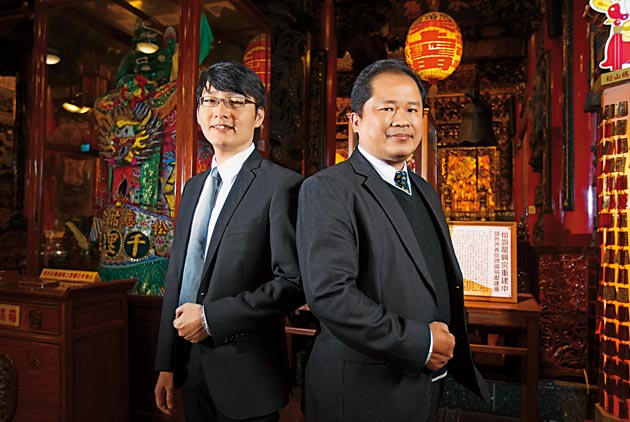Bank SinoPac
Bank 3.0, Shattering and Preserving Tradition

Source:CW
Sinopac is making strides in adapting its banking services to the always-connected society of today.
Views
Bank 3.0, Shattering and Preserving Tradition
By Peihua LuFrom CommonWealth Magazine (vol. 590 )
Each year, throngs of the faithful descend upon the 262-year-old Tzu-yu Temple (慈祐宮) in Taipei’s Songshan District. Packing the small shrine, they come to light lanterns for good luck before the Chinese New Year. This year is different, however, as three out of every 10 worshippers choose to pay for their lantern lighting via bank wire transfer instead of cash.
What do ATM transfers have to do with lighting prayer lanterns?
The story goes back to last year, when Bank SinoPac brought an ATM machine to the temple, complete with shortcut buttons, so that when you inserted your bank card, you could transfer funds to the temple’s account at the touch of a button and get right to lighting a lantern. This particular ATM machine was decorated by hand with cartoon-style likenesses of the gods. “We discussed the hand-painted illustrations with Tzu-yu Temple authorities; it’s not like we could draw anything we wanted,” says Echno Lin, manager of the Bank SinoPac Songshan branch.
Lin came up with the idea at first only to help resolve the issue his branch’s biggest client, Tzu-yu Temple, had with transporting cash. The Songshan bank branch and Tzu-yu Temple began talking about their ATM plans over a year ago. Once electronic finance came into play, it became possible to offer the added value of lantern-lighting services. Having knocked on the door with an ATM machine familiar even to older worshippers, the next step for Bank SinoPac is to design an app for Tzu-yu Temple so users can light a lantern online.
Ting Chen, chief executive of financial products at Bank SinoPac, gleefully relates that Tzu-yu Temple’s success has resulted in extensive business from other temples.
Boasting a background in e-commerce, Ting Chen held the position of head of electronic banking until she became chief executive of financial products, where she is responsible for the proliferation of digital finance through all products.
“We are a medium-sized bank that has taken a different path through digital finance, to compete with other, large banks,” says Jia Hong Liao, senior vice president in charge of the bank’s human resources division.
After six months of intense internal debate, Bank SinoPac came up with the areas in which bank personnel would have to transform, becoming industry experts, roving clerks, and customer experience designers.
Ting Chen believes that in the future bank personnel must become industry experts. Taking the example of the temple “industry”, nobody had penetrated this realm in the past, but Bank SinoPac accumulated specialized knowhow thanks to the successful case of Tzu-yu Temple, which has in turn enabled it to expand to numerous temple locations.
Another example would be bank staff capable of helping with tax planning at the same time as they sell home mortgages, which would solidify their utility and ensure that they are not supplanted.
On-air Branches Work into the Night
As customers make fewer trips to their local bank branch, Bank SinoPac believes that on-air banking will become increasingly important moving forward.
Liao notes that people frustrated with telephone-based bank service have looked instead to on-line services. However, customer trust is hard to build when they have only virtual dealings with their bank, while phone services are able to provide that additional element of human warmth.
Consequently, this year Bank SinoPac has set up a 500-person on-air branch, equivalent to one-tenth of all staff bank-wide. In addition to cross sales and customer service, they added new roving financial management and cloud-based account (ToGo) staff.
Using ToGo services established last May, customers can make an appointment on line, receive a call from a staff member within an hour, and a specialist will meet them at an appointed location within 24 hours. ToGo team members have flexible work hours, and have been mobilized to help 800 customers set up accounts so far. Due to the frequent late night hours, “We’ve equipped them with mace for self protection,” adds Ting Chen
Remote financial management experts are specially selected candidates sourced from among telephone service staff for their proactive attitudes and willingness to learn. Upon undergoing formal staff training and obtaining requisite licenses, they make the jump to roving, on-air financial planning experts.
The move to Bank 3.0 has unexpectedly enhanced the value of remote customer service. Ting Chen explains that thinking of customer service as a surrogate for virtual networks makes it seem expensive, but seen as a substitute for bank branches, it actually appears quite inexpensive.
As digital technology transforms every aspect of service, banks’ support structures have undergone transformation. As a result, such mid- and back-end aspects as paperwork and legal affairs, traditionally handled to the letter and by the book, must transition to become active forces of workflow transformation.
Bank SinoPac has begun promoting design thinking within the organization, designing interfaces and workflows from the perspective of resolving customer problems.
“The first order of business when it comes to design is observation,” relates Ting Chen. Late last year, Bank SinoPac held a workshop for staff members at the section chief level and above. The proceedings kicked off with a five-minute video depicting the purchase of various items. After the film, product managers, section chiefs, and department heads were asked to write down what they had seen.
Ting Chen describes her work as somewhat like brainwashing. In order to break the habits of backend staff used to merely taking and acting on orders, she started referring to them as “sociologists” and “workflow designers,” training operational personnel to observe customers, analyze data, and to emulate digital development workflow, getting untrained third parties to conduct tests, and make multiple refinements before systems go on-line. This way, “The entire staff buys into the idea that change is necessary,” says Chen.
Translated from the Chinese by David Toman






